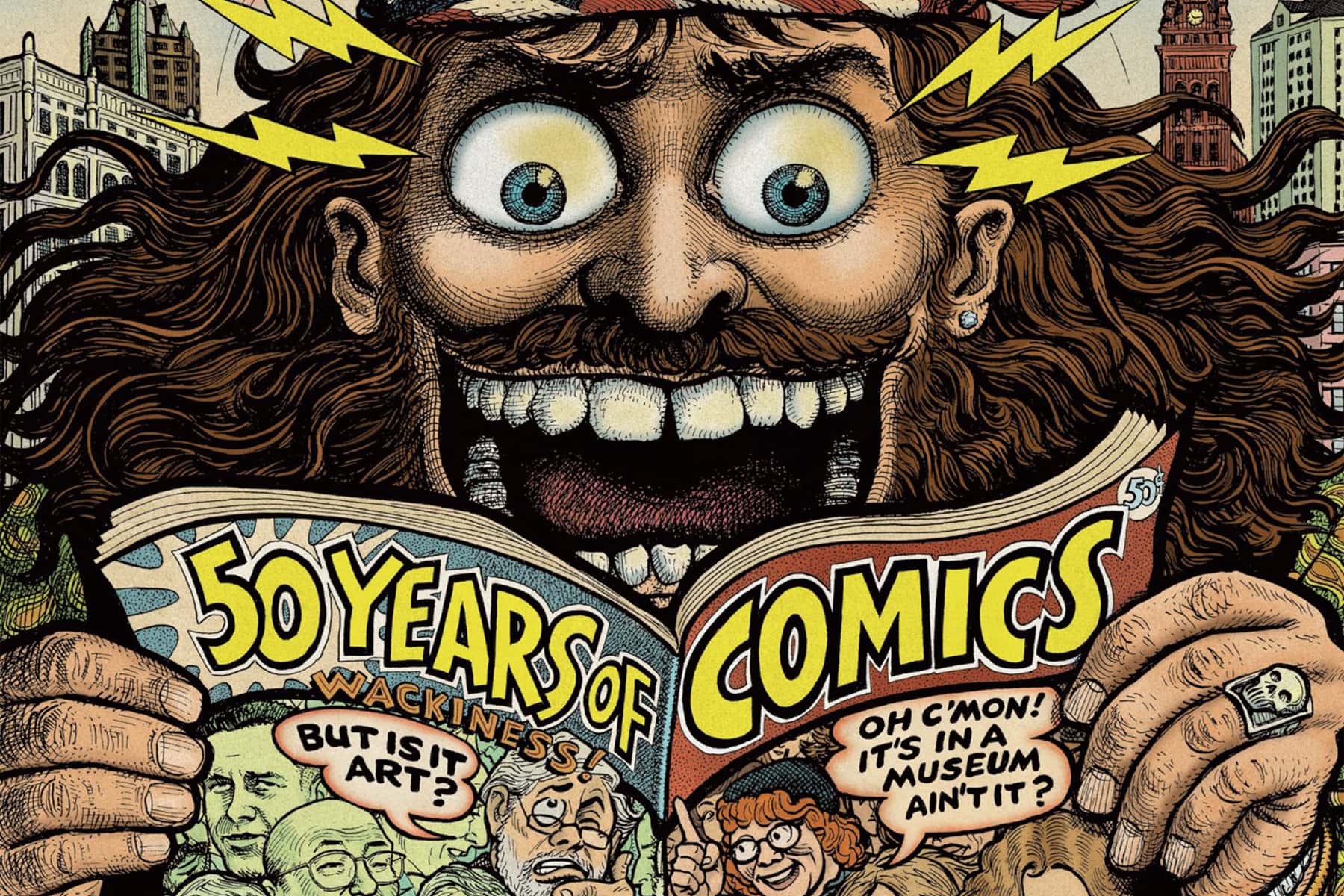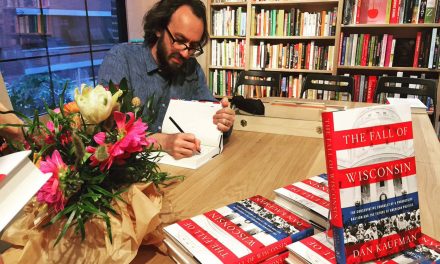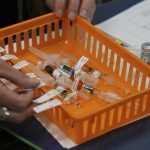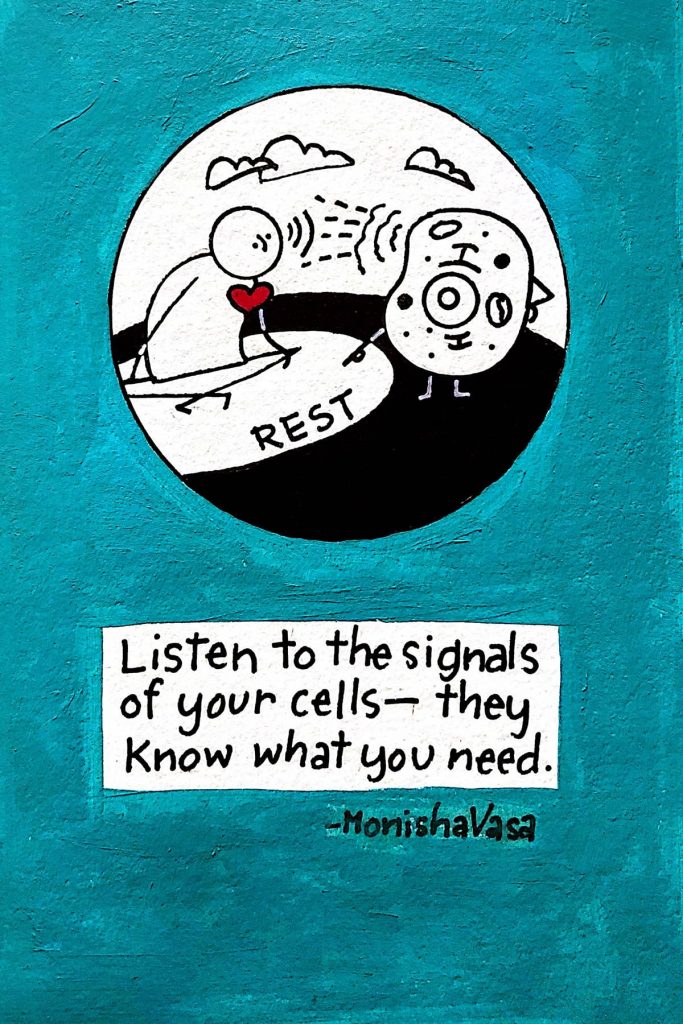
The Badger State’s rich cartooning history has been celebrated at an exhibit that opened August 8 at the Museum of Wisconsin Art. “Wisconsin Funnies: 50 Years of Comics” will be on display through September 27 at the West Bend museum and Saint Kate — The Arts Hotel in Milwaukee.
The split location and timing are intended to coincide with the upcoming Democratic National Convention, so visitors to the greater Milwaukee area might find a welcome dose of humor that goes down well with current events.
“There’s a lot to be said for levity that values individual ability and creative vision,” said Tyler Friedman, the museum’s associate curator of contemporary art.
Nearly 200 works by 25 artists are on display, illustrating important themes, innovations and publications. The exhibition pairs hand-drawn original art with printed material including comic books, newspapers, and collectibles.
“Part of the reason why this is so exciting is because comics have this largely untold story,” says Friedman. “Generally speaking, people have not appreciated the formative role that Wisconsin has played in comics culture throughout history.”
Cartooning goes back a long way. Sunday comics had been around for only a decade when Sauk County native Clare Briggs (1875-1930) invented the daily comic strip, in 1904, for a Chicago paper. Tomahawk native H.T. Webster (1885-1952) created a character named Casper Milquetoast, who became so popular that his last name is now in the dictionary, defining a shy, meek person. Gasoline Alley, by Cashton’s Frank King (1883-1969), created a sensation by having his characters age in real time. Launched in 1918, the comic strip’s residents went to war, had babies and became grandparents – right along with their readers.
Those stories are explored in the museum catalog, written by curators and historian Paul Buhle, while the exhibit itself takes a special look at comic books in the last half-century, especially the influential role played by Denis Kitchen.
It is perhaps no coincidence that he is from Racine, late but longtime home of the massive Western Publishing Company. Under various imprints, for decades it published Walt Disney’s Comics and Stories, Donald Duck, Little Lulu, Bugs Bunny, Woody Woodpecker, Star Trek, Boris Karloff Tales of Mystery, Magnus, Robot Fighter, and dozens of other comic book titles. Changing industry dynamics forced Western to end its comics line in 1984.
Meanwhile, Kitchen was pioneering a whole different approach. He was one of the founders of the 1970s Bugle American, an alternative weekly paper based Milwaukee. Its comics pages included the work of a new era of cartoonists, such as Kitchen, Bruce Walthers and Robert Crumb, who explored real-world topics and adult issues, such as national politics, foreign relations, drug use and the spectra of gender identity and sexual orientation, often using frank language.
To further their work, in 1970 Kitchen launched a publishing company, Kitchen Sink Comics. Now-renowned titles included Bizarre Sex, Bijou Funnies and Death Rattle. They were distributed in head shops and record stores nationwide, and — to distinguish themselves from more conventional comic books — they were called “comix.”
And their creators never, ever thought their work would someday hang in a museum.
“No. No, honestly never,” says Kitchen. “When I was young comics were considered pretty low on the cultural scale, and the kind of comics — underground comix — I was doing were downright disreputable to most of America at that point.”
They were not mainstream, and that was the point. “I think we were viewed as part of an outlaw culture that certainly the middle class did not comprehend. Nor did we care, because we were strictly producing things for our peer audience,” he said. “At the time we didn’t even use the term ‘hippie,’ but sure. That’s what we were.”
Over time Kitchen Sink went beyond that, to rediscover and bring appreciation to historic comic artists whose work had never been collected. New generations of fans came to appreciate the filmic noir genius of Will Eisner’s The Spirit, reprinted by Kitchen Sink, master of adventure Milt Caniff (“Terry and the Pirates,” “Steve Canyon”), and even the quiet brilliance of Ernie Bushmiller’s bushy-haired “Nancy,” a deceptively simple comic strip that today is viewed as a master class in cartooning. Kitchen Sink continues to offer new works, collections and reprints.
Within the industry, it is a cliché that the funnies have become serious business. Less than a year ago cartoonist Lynda Barry of Richland Center received a MacArthur Foundation Genius Award for her pioneering work in enhancing creativity across disciplines including medicine, through her cartooning instruction at the University of Wisconsin-Madison. Her textbooks have become influential, if unlikely, best-sellers.
And then there are comics as literature. Mike Baron, whose 1980s Nexus comic books have become science fiction classics, recently re-explored its themes in “Nexus: A Novel.” Baron is at work on a new graphic novel, Florida Man. “Funniest book ever written,” he promises. Winner of industry top honors such as the Eisner, Harvey and Kirby Awards, Baron’s Madison work with Jeff Butler and Steve Rude are part of the exhibit.
Visitors to the Museum of Wisconsin Art and Saint Kate “have the opportunity to get familiar not only with Wisconsin’s role, which is very central in the development of comics, but they’re going to have an opportunity to do a comparison,” said James Danky, co-curator of the exhibit with Friedman and Kitchen, and faculty member at the University of Wisconsin-Madison School of Journalism and Mass Communication.
He emphasized the contrast between physically printed images held on a reader’s hands versus an artist’s original ink on paper.
“I think the principle that Denis and I have employed is to take something that you know, that has been widely available, and then to have a chance to see the original art, which almost nobody has ever had a chance to do,” said Danky. “It hasn’t shown up on museum walls until recently. That’s been an important part of the argument that Denis and I have been making: that it deserves to be on museum walls. And it’s just taken nearly to the 21st century for that to happen.”
The three curator-collaborators joined in recommending the exhibit to families and young people as a unique educational opportunity, especially during the ongoing public health crisis. Said Danky, “My friend Lynda Barry is not going to be happy until everyone has a pen, pencil or brush in their hand.”
The Museum of Wisconsin Art has scheduling a variety of virtual opportunities and special events, including an exhibit video “walk through” with Danky and Friedman. Educational materials have also been made available to teachers.
“Wisconsin Funnies: 50 Years of Comics” was made possible in part by grants from the National Endowment for the Arts, the Wisconsin Department of Tourism and the Wisconsin Humanities Council.
Museum of Wisconsin Art
Originally published on the Wisconsin Examiner as Badger style cartooning is a work of art
Donate: Wisconsin Examiner
Help spread Wisconsin news, relentless reporting, unheard voices, and untold stories. Make a difference with a tax-deductible contribution to the Wisconsin Examiner














